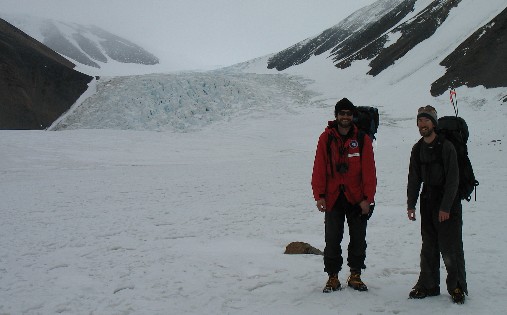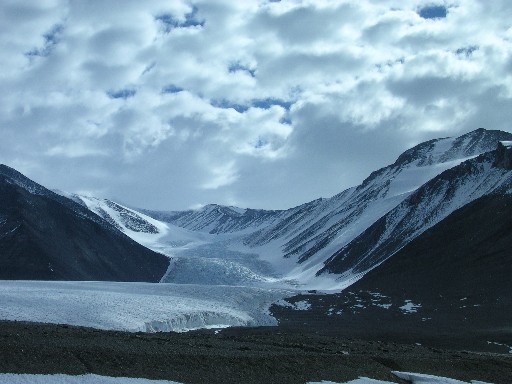 |
|
|
Home|Glossary|Links|Journal|Maps
At the Ice’s Edge Then it was my turn. I kicked in my crampons and swung the two ice axes. I couldn’t get off the ground at all. “Hit harder,” encouraged Gretchen. “Let out those aggressions!” “Yah, think of jerky ex-boyfriends,” advised Lawrence. “Think of not having any coffee in the morning,” recommended Ray. “Think of me snoring in the tent last night disturbing your peaceful slumber,” proposed Kirk. The suggestions worked. Little by little I got above the ground, small flakes of ice flying here and there as I did so. “You know,” joked Shelley, “we should study the effects of ice climbing on glacier ablation.” Ablation is the term glaciologists use to describe the loss of mass from a glacier. It encompasses processes such as melting, evaporation, sublimation, deflation, and calving. Melting, evaporation, and sublimation involve the change of phase of water. During melting, water changes from solid ice to liquid form; during evaporation it changes from liquid to gas; and during sublimation it changes directly from ice to a gas. Deflation involves the removal of ice by wind while calving is the breaking off of ice pieces from a glacier’s edge. In the valleys, sublimation is the chief form of ablation. As the stream team, though, we are most interested in melting because it is glacial meltwater that is the stream’s main source of water.
A few weeks later, we had moved into the adjacent Taylor Valley, which is the main valley in which we study streams. Our time with Shelley, Gretchen, and Lawrence seemed like a dream. But our present situation was rather surreal as well. Kirk, another stream team person, Josh, and I were hiking over Canada Glacier from the F6 camp to the Lake Hoare camp, and not too far from us were some immense ice falls, cascading down what looked like a giant staircase. We were following a flagged route over the glacier to avoid falling into crevasses, which are giant cracks in the ice that make glacier travel quite treacherous. But in this case, the flags also serve as mass ablation stakes. Glacier team members measure the height of these stakes at various times throughout the field season. If the height of the stake increases with time, then mass is being lost and that part of the glacier is in what’s known as an ablation zone. If a stake height decreases, then snow is building up in that area and that part of the glacier is in an accumulation zone. Depending on the relative amounts of ablation versus accumulation, a glacier may retreat or advance over time. These terms refer only to the position of the glacier’s end or terminus. Even when a glacier is retreating, though, it is still moving forward. It’s just that more ablation is occurring than is compensated for by the glacier’s forward movement. Another few weeks passed and again, we were headed to the Lake Hoare camp. Depending on the time of day, the camp lies in the shadow or the reflected sunlight of Canada Glacier, and the glacier is a constant presence in our lives. When we look out the window while washing dishes, it is there. When we walk to the lab buildings or tool shed, it is there. And when we decide to go to the beach at the glacier’s base and play Frisbee on warm sunny nights, it is - quite fantastically - there as well. But this weekend is cloudy and very cold and is not beach weather at all. Instead, we opt to spend our nights playing some intense rounds of dominoes and of the board game Cranium. On Monday, my watch alarm goes off and seeps into my dreams. This morning is my last in the valleys. It is the end of our field season and the start of our journey north, back to the “real” world. I crawl out of my tent, knowing that the huge vertical ice cliffs of Canada Glacier will tower above me. Rubbing my eyes open, I slowly wake up. - Karen References: |

